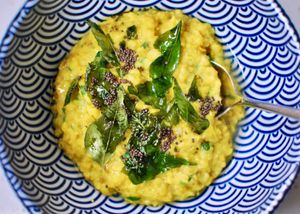One of the first ‘prescriptions’ my Ayurvedic doctor gave me was to start eating kitchari. ‘Had I heard of it?’ she asked. I had, but I’d never cooked it nor eaten it; I was much more familiar with the Britishized version, kedgeree, which incidentally is not Ayurvedic at all as it includes (smoked) fish and eggs, an incompatible combination in Ayurveda. (When making my own version these days, I have the eggs but not the smoked fish, which isn’t considered a great choice either. Or some tinned tuna and no eggs.)
So what’s so great about kitchari (which you might see spelled kitcharee, khichadi, kitchadee . . .), an Indian-spiced savoury porridge made from mung dal and rice? It’s considered a balancing, healing meal in Ayurveda – very easy on the digestive system and nourishing for the body. It’s also simple and quick to make, and I eat it at least once a week for lunch or dinner. Importantly, it’s also delicious. This is no bland sludge; it’s comfort food for the soul.
One of the many challenges I faced at the peak of my digestive disorder was having no idea what to eat when things were off kilter. Now, this is one of my go-tos. It’s also great when recovering from illness and regrounding after travel. If your digestion feels on the weaker side, reduce the quantity of spices until things settle.
You’ll find many variations for kitchari out there, and here’s mine. If you know your dosha, you can adjust the spices and additions to suit. I also switch up the spices for variation every now and then, using fenugreek instead of fennel for instance, or cardamom instead of cumin. Or in the winter I might add some warming spices like cinnamon or clove.
